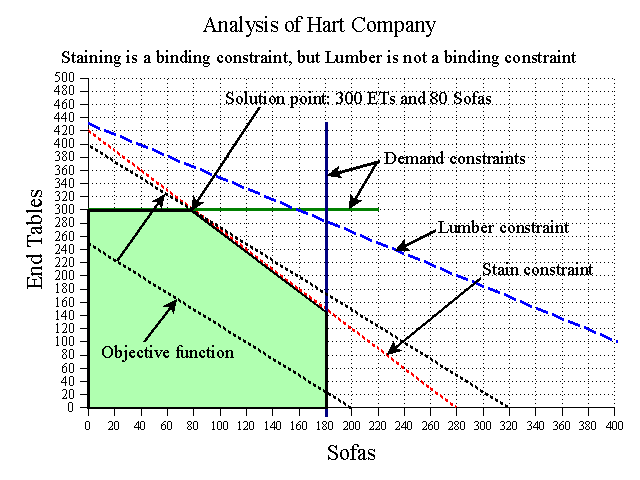
Provided by James R. Martin, Ph.D., CMA
Professor Emeritus, University of South Florida
TOC Main
Page | TOC Problems Main Page
Hart Furniture Company produces two products, End Tables and Sofas that are processed in five departments, Saw Lumber, Cut Fabric, Sand, Stain, and Assemble. End tables are produced from raw lumber. Sofas require lumber and fabric. Glue and thread are plentiful and represent a relatively insignificant cost that is included in operating expense. The specific requirements for each product are provided in the table below.
| Resource or Activity & (Quantity available per month) |
Required per End Table | Required per Sofa |
| Lumber (4,300 board feet) | 10 board ft @ $10 = $100 | 7.5 board ft @ $10 = $75 |
| Fabric (2,500 yards) | - | 10 yards @ 17.50 = $175 |
| Saw Lumber (280 hours) | 30 minutes | 20 minutes |
| Cut Fabric (140 hours) | - | 20 minutes |
| Sand (280 hours) | 30 minutes | 10 minutes |
| Stain (140 hours) | 20 minutes | 30 minutes |
| Assemble (700 hours) | 60 minutes | 90 minutes |
The Company's operating expenses are $75,000 per month. Based on current demand, the company can sell 300 End Tables and 180 Sofas per month. Sales prices are $300 for End Tables and $500 for Sofas.
Required:
1. Determine Hart Company's constraint.
2. Determine the throughput per minute of the constrained resource for each product.
3. Determine the product mix needed to maximize throughput, i.e., the number of End Tables and Sofas that should be produced per month.
4. Determine the maximum net income per month for Hart Company.
5. Suppose Hart Company broke the current constraint resource. What would become the new constraint?
6. Solve the Hart Company product mix problem assuming that only 3,000 board feet of lumber can be obtained rather than 4,300 board feet.
Solution
As indicated in the first example, the following approach can be used to solve a simple product mix problem when there is only one binding constraint, i.e., no overlapping constraints.
1. Determine Hart Company's binding constraint.
Resource requirements to meet demand for each department are calculated as follows:
| Activity & (Quantity available per month) |
End Table | Sofa | Total Amount of Resource Required Per Month |
| Lumber (4,300 board feet) | (10 board ft)(300) | (7.5 board ft)(180) | 4,350 board feet |
| Fabric (2,000 yards) | - | (10 yards)(180) | 1,800 yards |
| Saw (16,800 min) | (30 min)(300) | (20 min)(180) | 12,600 minutes |
| Cut &Trim (8,400 min) | - | (20 min)(180) | 3,600 minutes |
| Sand (16,800 min) | (30 min)(300) | (10 min)(180) | 10,800 minutes |
| Stain (8,400 min) | (20 min)(300) | (30 min)(180) | 11,800 minutes |
| Assemble (42,000 min) | (60 min)(300) | (90 min)(180) | 34,200 minutes |
The Stain activity is the binding constraint because it does not have enough capacity to process 300 End Tables and 180 Sofas per month.
2. Determine the throughput per minute of the constrained resource for each product.
First we need to determine the throughput per unit for each product so that we can determine how to use the constraint to maximize throughput. Throughput per unit is as follows:
| Product | Sales price - Materials Cost | Throughput Per Unit |
| End Tables | $300 - 100 | $200 |
| Sofas | $500 - 250 | $250 |
Then we can determine the throughput per minute of the constrained resource for each product as follows.
| Product | Throughput
Per Unit ÷ Minutes required in Stain |
Throughput Per Minute |
| End Tables | $200 ÷ 20 | $10.00 |
| Sofas | $250 ÷ 30 | $8.33 |
3. Determine the product mix needed to maximize throughput, i.e., the number of End Tables and Sofas that should be produced per month.
Maximizing throughput requires producing as much of the product with the highest throughput per minute of the constrained resource as needed to meet demand. So the company should produce 300 End Tables. This requires (300 units)(20 minutes) = 6,000 minutes of time in the constraint and leaves 8,400 - 6,000 = 2,400 minutes for the production of 80 Sofas, i.e., 2,400 minutes ÷ 30 minutes per unit = 80.
Graphic Analysis
The following graphic analysis provides a general approach for solving simple product mix problems that is also applicable when there are overlapping constraints.
First, plot the constraints to find the feasible solution space. The staining constraint is 20ET + 30S = 8,400 minutes, so staining could produce 420 ETs (8,400/20) or 280 Sofas (i.e., 8,400/30), or some combination of ETs and Sofas indicated by the constraint line connecting those two points on the graph. The Staining constraint and demand constraints define the feasible solution space indicated by the green area on the graph. The lumber constraint is 10ET + 7.5S = 4,300 so the company could produce 430 ETs (4,300/10) or 573.33 Sofas (4,300/7.5) with the available lumber. Plotting the lumber constraint shows that it is not a binding constraint, i.e., it does not limit the feasible solution space on the graph.
Next, check the amount of throughput that could be obtained at each corner point, or plot the objective function 200 ET + 250S and move it up and to the right as far as possible without leaving the feasible solution space. The first objective function is plotted to indicate the slope of the function (200/250 = .8 means that it takes only .8 of a Sofa to produce as much throughput as 1 ET) and shows that 250 ETs produces the same throughput as 200 Sofas, i.e., (250 ETs)($200) = (200 Sofas)($250) = $23,500. Either approach (checking the corner points or using the objective function) reveals that 300 ETs and 80 Sofas is the optimum solution.

4. Determine the maximum net income per month for Hart Company.
| Sales: | ||
| 300 End Tables = (300)($300) | $90,000 | |
| 80 Sofas = (80)($500) | 40,000 | $130,000 |
| COGS: | ||
| 300 End Tables = (300)($100) | $30,000 | |
| 80 Sofas = (80)($250) | 20,000 | 50,000 |
| Throughput | 80,000 | |
| Less Operating expense | 75,000 | |
| Net income | $5,000 |
Note: An assumption in this illustration is that there are no
beginning or ending inventories
of work in process or finished goods. See the Pop
Company problem for an illustration with beginning and ending inventories.
5. Suppose Hart Company broke the current constraint. What would become the new constraint?
Breaking the Stain activity constraint would cause Lumber to become the constraint resource because 4,350 board feet are needed and only 4,300 board feet are available per month.
6. Solve the Hart Company product mix problem assuming that only 3,000 board feet of lumber can be obtained rather than 4,300 board feet.
Where there are overlapping constraints as in this case, the solution obtained using the first approach indicated above is not recommended. The graphic approach is more reliable.With only 3,000 board feet of lumber, the company can produce 300 ETs (3,000/10) or 400 Sofas (3,000/7.5), or some combination of the two as indicated by the new lumber constraint line on the graph.
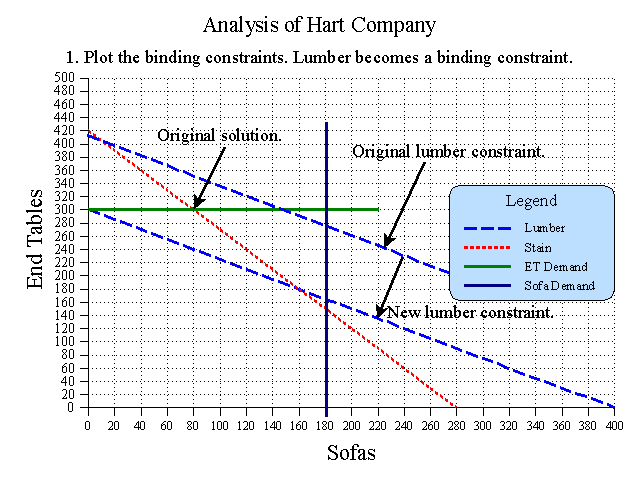
The feasible solution space is smaller than before and is now defined by lumber and staining as well as product demand as indicated in the graph below.
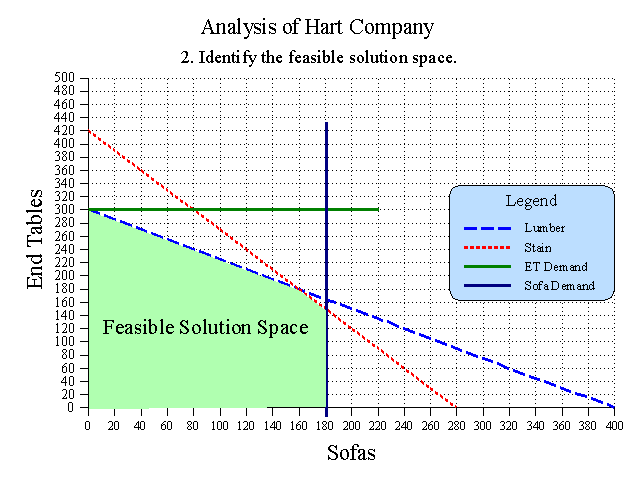
The solution can be found by examining the potential throughput at each of the corner points 1, 2, 3, and 4.
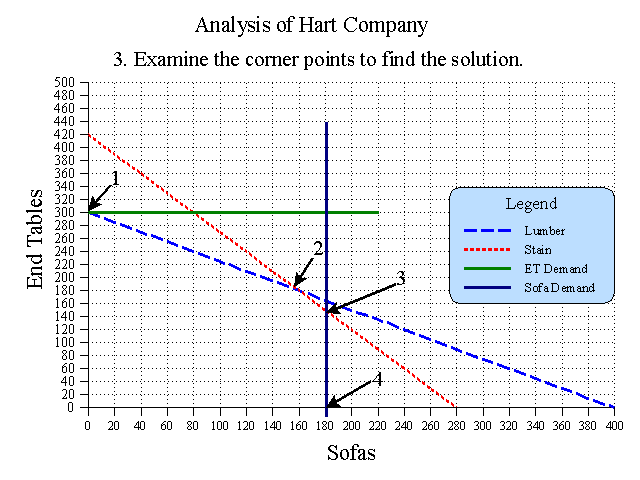
| Corner Point | Throughput |
| 1. 300 ETs and zero Sofas | (300)(200) = 60,000 |
| 2. 180 ETs and 160 Sofas | (180)(200) + (160)(250) = 76,000 |
| 3. 150 ETs and 180 Sofas | (150)(200) + (180)(250) = 75,000 |
| 4. Zero ETs and 180 Sofas | (180)(250) = 45,000 |
Point 2 provides the solution because it provides the greatest amount of throughput.
The solution can also be found by using the objective function. If we plot the objective function we can locate the solution by moving it to the outer most point in the feasible solution space as illustrated below. The point indicated by 180 ETs and 160 Sofas is the last point the objective function touches in the feasible solution space as we move it up and to the right. This point indicates the solution to our product mix problem. The objective functions in the graph are iso-throughput lines indicating that any combination of ETs and Sofas on the line produces the same amount of throughput, i.e., $23,500 of throughput for the lower function and $76,000 for the function indicating the solution point.
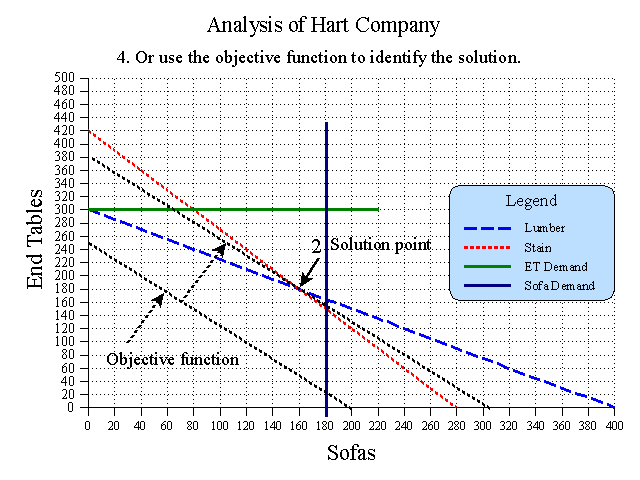
The graphic solutions to the Hart Company problem and the TOC problem are both fairly simple. For problems with multiple products and multiple constraints there is no graphic equivalent, but these simple problems provide a conceptual view and introduction to more realistic product mix problems and are useful for introducing both TOC and the linear programming technique.
__________________________________________________
*Blocher, E. J., K. H. Chen and T. W. Lin. 2001. Cost Management: A Strategic Emphasis, 2nd edition. Irwin McGraw-Hill.
Related problems and summaries:
Goldratt, E. M. 1990. The Haystack Syndrome: Sifting Information Out of the Data Ocean. New York: North River Press. (Summary).
Martin, J. R. Not dated. TOC Problem 1: Find the constraint and the product mix needed to maximize throughput. Management And Accounting Web. TOCClassProblem1.htm
Martin, J. R. Not dated. TOC Problem 3: Determine the optimum product mix with overlapping constraints. Management And Accounting Web. TOCClassProblem3.htm